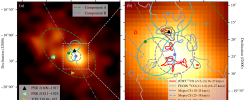May 2023
By definition, Black Holes (BHs) are difficult to detect. However, many studies have now conclusively demonstrated that BHs exist – both in the mass range of a few to tens of solar masses (called stellar-mass BHs), and in the range of millions to billions of solar masses (called supermassive BHs). Stellar-mass BHs are thought to be formed in the final stages of the lives of massive stars. They may coalesce (as the gravitational radiation detected from such mergers suggests), gradually forming the supermassive BHs that are found in the centers of our own and other galaxies.
It has long been speculated that Black Holes may also have formed in the Big Bang that generated our entire universe, and the processes that could have formed BHs in this initial phase of the cosmos may have generated them with a very wide range of masses, possibly even BHs with a mass comparable to sky-scrapers [1] or lower. Such low-mass BHs would be tiny, with sizes comparable to subatomic elementary particles, and their gravitational force is so small that it would be much more difficult to detect them in space than their more massive stellar-mass BH counterparts.
And yet – one way of identifying such BHs had been proposed by Stephen Hawking [2] almost 50 years ago: In the vicinity of the event horizon that surrounds BHs of any size, quantum-physical processes cause the BHs themselves to ‘evaporate’ by emitting energetic particles and photons. This so-called Hawking radiation has very little effect on all but the least massive BHs, but the latter effectively loose all their mass over a period in time as long as the age of the universe.
The evaporation process speeds up until it ultimately results in a brief explosion as the last remnants of the BH give rise to a flash of very-high-energy photons and relativistic particles – very much like a fast and furious fire cracker (see Fig. 1). In our age, 13 billion years after the big bang, BHs that were formed initially with masses of about hundred million tons, end their lives in such bursts.

The flash that signals the end of the life of a Black Hole will result in a brief (few to hundreds of seconds long) flare of gamma-rays, that may be detected with telescopes such as H.E.S.S. The exact properties of such events (duration, temporal profile, brightness and energy distribution (spectra)) are subject to assumptions, as the detailed physical processes have not yet been witnessed.
In a new study that has just been published [3], the H.E.S.S. collaboration has used a large fraction of the observations of galactic and extragalactic fields obtained so far to search for flares that might have been caused by evaporating BHs. The trick is to search for periods where a number of photons is found in an area of the sky observed by the H.E.S.S. cameras that is significantly larger than one might expect to find by chance. The area of the actual target studied in the individual observations is disregarded, but the field of view covered by the H.E.S.S. telescopes is more than ten times larger than the area that needs to be excluded from this search.
Carefully estimating the number of coincidental photons that arrived within brief periods of time, the new study of the H.E.S.S. data concludes that no flares likely to have originated from evaporating Black Holes were detected in nearly 3000 hours of observations. The sensitivity of H.E.S.S. observations can then be used to derive a lower limit on the number of explosions that happened in our cosmological vicinity out to distances that depend on the models of the physical processes of BH evaporation (Fig. 2).

The limit on the number of explosions also implies a limit on the number of Black Holes in this mass range that formed in the Big Bang, as the evaporation as such is inevitable. This result rules out certain models about the formation of the universe which would otherwise have been impossible to address. Ultimately, the limit on the number density of BHs of such masses having been formed in the Big Bang also implies that BHs of masses in the range of tens of millions to billions of tons constitute only a very negligible fraction of all the mass in the universe and thus do not significantly affect the dynamics of stars and galaxies.
References:
[1] A recent review is given in: B. Carr and F. Kühnel, Primordial Black Holes as Dark Matter: Recent Developments, Annual Review of Nuclear and Particle Science 70 (2020) 355
[2] S. W. Hawking, Black Hole explosions?, Nature 248 (1974) 30
[3] H.E.S.S. Collaboration, Search for the evaporation of primordial Black Holes with H.E.S.S., JCAP04(2023)040, DOI:10.1088/1475-7516/2023/04/040
[4] Black Hole Radiation Simulated in Lab, Communicate Science


